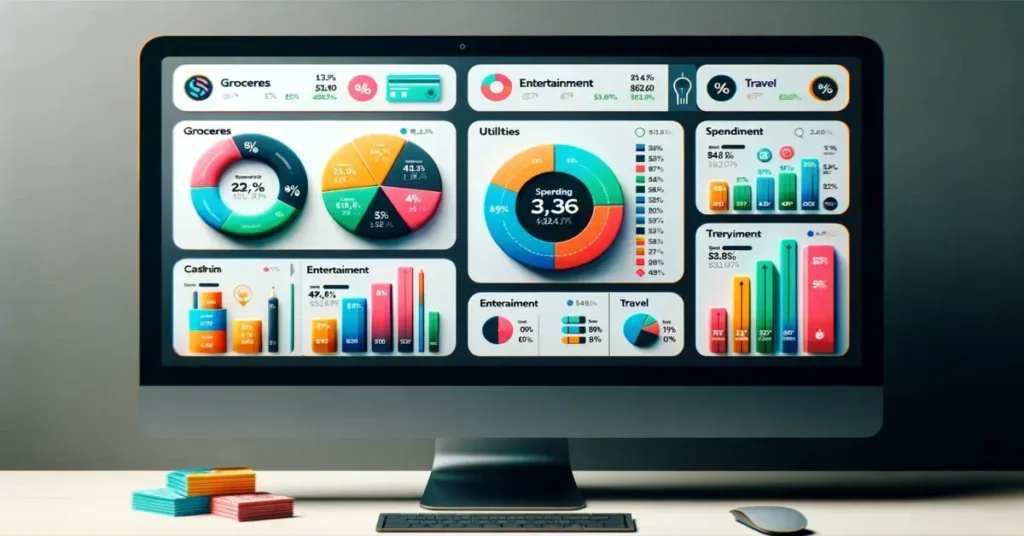Dive into budgeting by asking key questions that make managing money simpler. This guide helps you quickly understand how to track spending and save effectively, setting you on the path to financial freedom.
Feel free to copy my top budgeting questions and check your finances! 😉
My Most Important Budgeting Questions – What Are My Financial Goals?
Aligning my budget with my aspirations is critical for financial success. Here’s how I tackle my financial destinations across different time horizons.
Short vs Mid vs Long-Term Goals
Short-Term Goals (1-2 years):
- Emergency fund establishment, it’s like my financial safety net
- Paying off credit card debt, goodbye high interest!
Mid-Term Goals (3-5 years):
- Saving for a down payment on a home
- Starting a business fund for my dream café
Long-Term Goals (5+ years):
- Retirement savings, for peace of mind in my golden years
- College fund for my future kids, ensuring they have a bright start
How Do My Current Spending Habits Impact My Financial Goals?

When I take a good, hard look at my spending habits, it’s a real eye-opener to how they shape my financial future. It’s essential to ask myself if my everyday expenses are pushing me closer or pulling me away.
Essential Questions I Consider:
- Am I spending on things that matter to me in the long run?
- Does my current savings rate allow me to retire when I want?
Here’s What I’ve Learned:
- Every dime not saved today can mean dollars lost in compound interest tomorrow.
- If I’m not steering my ship with a budget, I could be off course without even knowing it.
By understanding my spending habits, I usually get excited! I’ve realized when I plan and track my expenses, I maintain control.
I make it a point to:
- Curtail impulsive buying and make room for more meaningful investments.
- Replace unfocused splurging with targeted saving, enhancing my journey towards financial freedom.
What Percentage of My Income Should I Allocate to Savings?
When I’m mapping out my financial future, it’s thrilling to think about the possibilities that saving can bring! One popular method I’ve found is the 60/20/20 rule, which is a clear and straightforward strategy. I break down my after-tax income and allocate 20% towards savings. This chunk goes into things like an emergency fund, retirement accounts, or other financial goals.
Here’s how I like to visualize it:
- 60% Needs: Essential expenses like housing and groceries.
- 20% Wants: The fun part! This is for hobbies, dining out, and entertainment.
- 20% Savings: Investments, savings accounts, and extra debt payments.
I understand that not every month will be the same, so flexibility is key in my budgeting approach. Sometimes I might save more than 20%, especially if I have a lighter month on expenses. But keeping that 20% as a baseline ensures I’m consistently building a financial cushion.
Sticking to this rule takes discipline, but it’s exhilarating to watch my savings grow! The sense of security and the opportunities that open up with a healthy savings account are worth the effort. And remember, as my income grows or changes, these percentages can adapt to fit my new circumstances. The goal is always to make saving a priority within my financial plan.
How Can I Categorize My Expenses for Better Tracking?
When it comes to managing my finances, I’ve found that categorizing my expenses is a game-changer! It’s all about creating a system that makes sense and simplifies the process of understanding where my money is going. Here’s how I break down my expenses:
Fixed Expenses: These are the bills that don’t change much from month to month. I’m talking about my rent/mortgage, utility bills, and subscription services. Keeping these separate makes it easy to see what’s a consistent outflow.
Variable Expenses: These costs can fluctuate, like groceries, gas, and dining out. I track these closely to identify where I might cut back if needed.
Discretionary Expenses: Ah, the fun category! This is for entertainment, shopping, and other non-essentials. It’s exciting to see where I can splurge a little when I’ve stuck to my budget elsewhere.
Unexpected Expenses: Life’s full of surprises, and this bucket is for those unplanned costs, such as car repairs or medical bills. It’s crucial to keep an eye on this to avoid being caught off guard.
And here’s a handy trick: I use budgeting apps that classify my expenses for better budgeting, which helps me to group my spending in a way that’s clear and tailored to my lifestyle.
What Strategies Can I Use to Reduce Unnecessary Spending?
When I look at my expenses, it’s like going on a detective mission where I uncover hidden wastes and pinpoint exactly where my money is slipping away. The thrill of finding those sneaky spending habits is just the first step. Here’s what I do to slash those costs:
- Track My Expenses: For a month, I meticulously note every purchase. Whether it’s a morning latte or an online subscription, I log it. Seeing where my money goes is eye-opening and forms the basis for my budgeting strategies.
- Automatic Savings: I treat my savings like a non-negotiable expense. Setting up an automatic transfer to my savings account makes it easier to build a cushion without feeling the pinch.
- Budgeting Apps: There are great apps out there that help me stick to my budget. By setting limits on different categories, I make sure I’m not overspending in areas that don’t matter as much in the grand scheme of things.
- DIY and Meal Prep: Whenever I can, I cook at home and repair things myself rather than buying new ones. I’m often amazed at how much fun it is to create meals for the week and get a little handy! Soon I will start sharing a few recipes with you!
- Avoid Impulse Buys: I wait 24 hours before making non-essential purchases. Often, the urge to buy fades, and I save money that I would have spent on a whim.
How Do I Adjust My Budget for Unexpected Expenses?
Life is unpredictable and surprises can have a financial impact—so I always ensure my budget is nimble. Here’s how I tweak it to accommodate those unforeseen costs:
Step 1: Anticipate & Assign
- Create a buffer: I build a ‘miscellaneous’ category right into my monthly budget for those just-in-case moments.
- Emergency fund: I contribute to an emergency fund regularly, aiming for three to six months’ worth of living expenses.
Step 2: Review & Redirect
- Income tracking: Each month, I track my income to spot any extra cash that could fortify my unexpected expense fund.
- Expense adjustment: If I encounter an unexpected cost, I review my categories to see where I can temporarily cut back.
Step 3: Reflect & Learn
- Regular check-ins: Holding monthly budget meetings with myself helps me stay proactive.
- Expense analysis: I examine each unexpected expense to better plan for the future—was it truly unpredictable, or should I consider a new budget category?
Step 4: Adapt & Enhance
- Flexible framework: My budget isn’t set in stone; I adjust allocations as my life and financial situation evolve.
- Technology tools: Utilizing budgeting apps helps me swiftly rearrange figures when needed.
What Tools or Apps Can Help Me Manage My Budget More Effectively?

In this digital age, I’ve discovered several fantastic tools and apps designed to make budgeting a breeze. These apps offer sleek interfaces, and automatic tracking, and help categorize my expenses, making financial management both fun and effective!
- User-Friendly Apps: I’m excited to share that some of the best budget apps for 2024 are designed with the user in mind. They sync with my bank accounts and automatically categorize my spending, which saves me a load of time!
- For Investment Beginners: If I’m looking to start investing alongside budgeting, there’s an app that serves this dual purpose. Stash is a top pick for beginners wanting to venture into the world of investing.
- Couples Budgeting: Budgeting as a couple? No problem! Apps like Honeydue are tailored to help partners manage their finances together smoothly.
- Free Options: If free is what I’m after, Mint is a stellar choice with almost five-star reviews. It’s renowned for its comprehensive expense-tracking capabilities.
Keeping Track of Bills and Subscriptions: Finally, never miss a bill or forget a subscription again with apps that are specifically designed to monitor recurring payments.
How Often Should I Review and Adjust My Budget?

Regularly assessing my budget is crucial for steering my finances in the right direction. Going over my budget with a fine-toothed comb ensures I’m on pace with my financial goals and prompt adjustments keep me from veering off course. So, how frequently should this happen?
- Monthly: At a minimum, I commit to a monthly budget review. This aligns perfectly with most billing cycles and helps me catch any overspending early on.
- Quarterly: Every three months, I take an extra step to review larger financial goals. It’s a chance to confirm that my budget still aligns with my long-term objectives.
- Annually: Yearly, I perform a comprehensive evaluation. This involves analyzing spending habits, reassessing financial goals, and making necessary changes for the upcoming year.
| Review Frequency | Purpose |
|---|---|
| Monthly | Track and tweak short-term spending |
| Quarterly | Align with medium-term goals |
| Annually | Adjust for long-term objectives |
Discipline is key, and staying engaged with my budget is how I harness control over my money.
What’s the Best Way to Handle Debt Within My Budget?
When I look at my budget, I get fired up about finding clever ways to tackle my debt. Let’s break it down:
- List All Debts: I start by laying out all my debts. I mean everything from credit card bills to loans. I organize them by the balance size and interest rate.
- Smallest to Largest: It’s thrilling to pay off the smallest debt first. This method, commonly known as the “snowball approach,” gives me quick wins that boost my motivation to keep going!
- Minimum Payments: While focusing on one debt at a time, I stay consistent by making minimum payments on the rest. It’s like juggling—I keep all the balls in the air, but I’m tossing extra at one until it’s gone!
- Find Extra Cash: I hunt for ways to increase my payments. Maybe it’s cutting back on dining out or picking up a side hustle. Every extra dollar goes straight to my target debt.
- Rolling Over Payments: Once a debt is vanquished, I don’t let that money rest! I roll over the sum to the next debt. If I was paying $100 extra on the first debt, now that $100 stacks onto the minimum I was already paying on the next. It’s like a snowball getting bigger—so satisfying!
- Consider Consolidation: If my debts have high interest, I might consider debt consolidation, which can potentially lower my interest rates and help me pay off debt faster.
Structured right, my budget helps me to break free from debt. It’s all about strategy, consistency and finally watching those balances hit zero!
How Can I Make Budgeting a Consistent Part of My Life?
Embracing budgeting as a daily ritual can be transformative for my financial health. Here’s how I manage to weave it seamlessly into my routine:
- Set Clear Financial Goals: These are the beacon that steers my budgeting journey. Whether saving for a vacation, paying off debt, or building an emergency fund, having specific goals makes budgeting meaningful and motivating for me.
- Automate Tracking Expenses: I rely on apps to simplify the tracking of my spending. This automation helps me see where my money goes without the chore of manual logging.
- Regular Check-ins: I treat my budget like a vital appointment. Whether it’s weekly or monthly, I commit to reviewing my finances regularly. Making these check-ins a fixture in my calendar helps ensure I don’t overlook them.
- Integrate Budgeting into Daily Decisions: Before making a purchase, I ask myself, “Is this aligned with my budget and financial goals?” Budgeting is not just about tracking; it’s about making informed decisions that align with my financial targets.
- Reward Progress: I celebrate when I hit milestones. Small rewards keep my spirits high and reinforce the habit of budgeting.
- Stay Informed: Knowledge is power, and learning the basics is crucial to my success. Understanding simple strategies such as the 50/30/20 rule elevates my budgeting confidence.
- Adjust as Needed: Life isn’t static, and neither is my budget. When my circumstances or goals change, I adapt my budget to fit. It’s a living document, not set in stone.
Frequently Asked Questions
What is the 70 20 10 rule money?
Allocating 70% for what you need, 20% for what you want (either immediate luxuries or future savings goals), and 10% for your goals (like paying off debts and saving or investing in your future).
What is the 50 30 20 budget rule?
Allocating 50% for what you need, 30% for what you want (either immediate luxuries or future savings goals), and 20% for your goals (like paying off debts and saving or investing in your future).
How do you budget for beginners?
- Calculate your monthly income, pick a budgeting method and monitor your progress.
- Try the 60/20/20 rule as a simple budgeting framework.
- Allow up to 60% of your income for needs.
- Leave 20% of your income for wants.
- Commit 20% of your income to savings and debt repayment.
These steps help budgeting become an intrinsic part of my life, much like my morning coffee ritual. It’s all about creating a budget that works for me and sticking to it.
Your journey on my budgeting questions doesn’t have to end here! I want to hear your unique experiences on the topic, so feel free to dive into the discussion in the comments section.
Intrigued for more? Explore our related articles for additional wisdom and guidance:
- Budgeting For Young Adults 2024: Fun Ways To Manage Money
- Budget Basics 2024: Simple Tips For Managing Your Finances
- How to Start 60 20 20 Rule For Beginners In 2024
- Budgeting For Meals: Tips To Save Money On Your Grocery Bill 2024
Don’t miss out on the newest financial trends and ideas – join our vibrant Pinterest community for regular updates and inspiration!






